Mysteries of the Brook Kidron unravel, revealing its profound biblical significance and hidden stories waiting to be discovered.
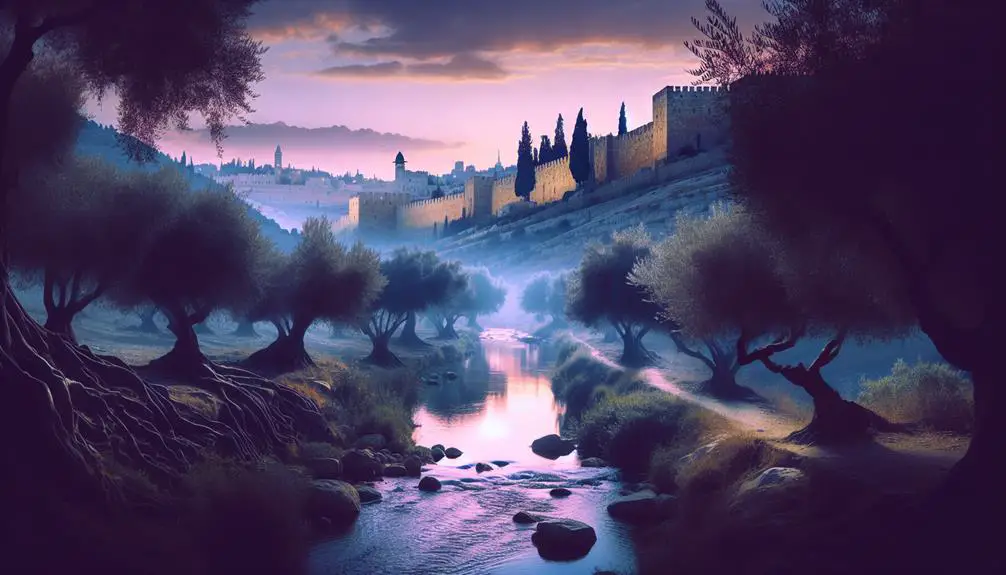
Brook Kidron in the Bible
As a river of history and mystery, the Brook Kidron weaves through the Bible, symbolizing both division and destiny. You'll find it at pivotal moments, from David's heart-wrenching flight from Absalom to Jesus' solemn journey on His final night. Its waters have silently witnessed the unfolding of biblical history, carrying layers of symbolic meanings and prophetic references.
But beyond its ancient banks lie hidden stories and archaeological discoveries that beckon for a closer look. Why does this seemingly modest stream hold such a significant place in the biblical narrative and what secrets does it still hold for us today? Let's explore the depths of its significance together.
Key Takeaways
- Brook Kidron symbolizes the transition from the profane to the sacred in biblical narratives.
- It marks a significant spiritual and political threshold, as seen in David's flight from Absalom.
- The brook serves as a site for purification, judgment, and renewal amidst crises.
- Archaeological discoveries at Brook Kidron provide insights into ancient burial customs and ritual practices.
Historical Significance
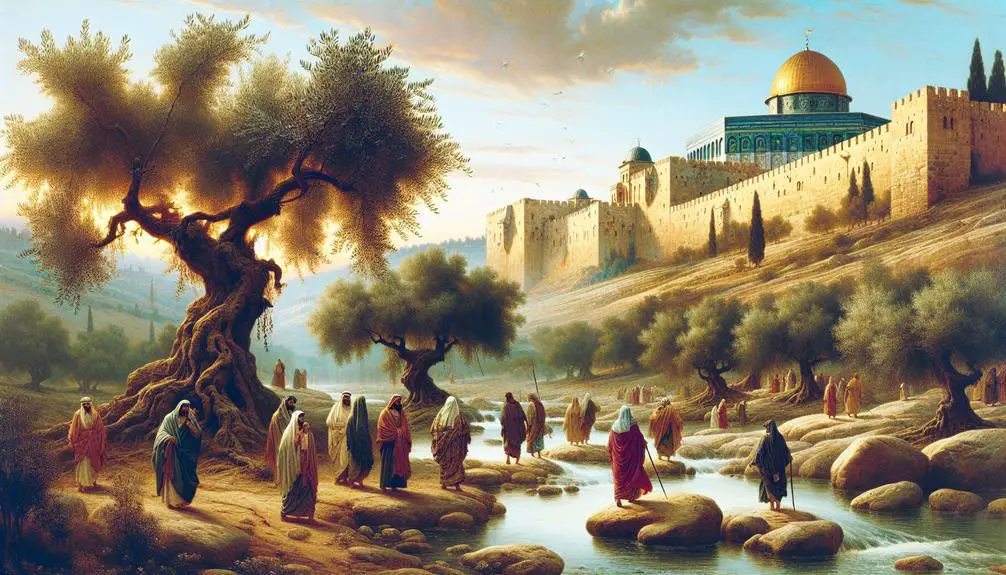
Throughout its storied past, Brook Kidron has served as a significant geographical and symbolic boundary in biblical narratives, shaping the religious and cultural landscape of the region. Its geographical location, situated to the east of Jerusalem, adjoining the Temple Mount, has made it a notable landmark in the Judaic tradition. You'll find that the Brook Kidron isn't just any water source; it's a testament to the intertwining of natural elements with spiritual significance.
The brook's course, running through the Kidron Valley, between the Mount of Olives and the city of Jerusalem, has acted as a natural demarcation line throughout history. This geographical significance is amplified by its biblical mentions, where it often symbolizes a line of separation between the sacred and the profane. The water source, primarily being a seasonal stream, fills during the rainy season, which has historically provided water but also a metaphor for spiritual cleansing and renewal in biblical texts.
Analyzing its role, you understand that Brook Kidron's historical significance isn't merely about its physical presence. It's about how this geographical feature has been woven into the fabric of religious narratives, becoming a potent symbol of purification, division, and transition. The water flowing through it carries not just the sediment of the Judean hills but also the weight of centuries of spiritual and cultural narratives.
In essence, the historical significance of Brook Kidron, with its unique geographical location and role as a water source, underscores its pivotal role in the religious, cultural, and historical consciousness of the region, making it a subject of scholarly interest and reverence.
David's Flight From Absalom
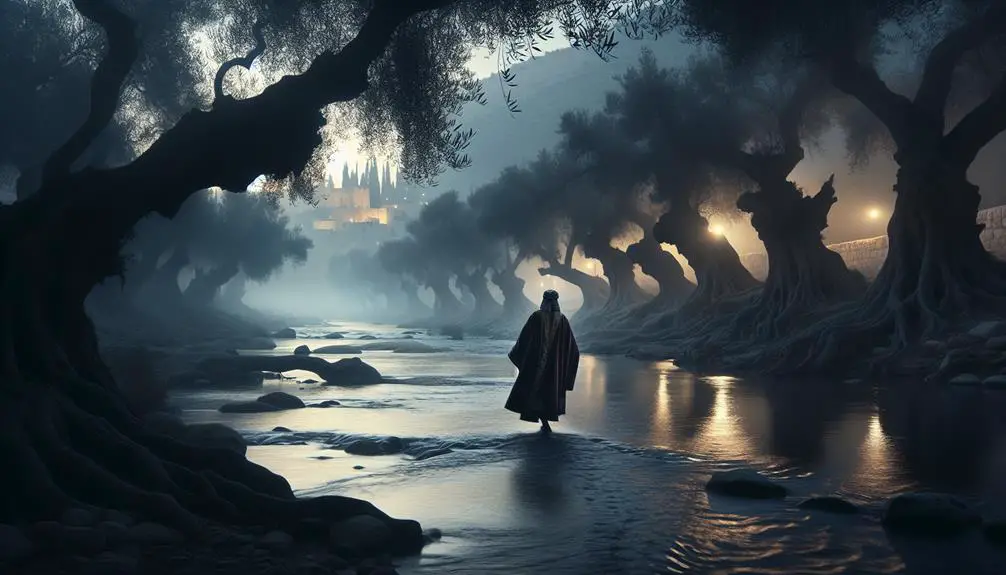
You must consider the profound emotional turmoil David experienced during his flight from Absalom, a pivotal event that underscores his vulnerability.
His crossing of Brook Kidron not only symbolizes a physical departure from Jerusalem but also marks a significant spiritual and political threshold.
Furthermore, Absalom's initiation of pursuit catalyzes a complex series of events, reflecting the intricate power dynamics and familial strife within the narrative.
David's Emotional Escape
David's flight from Absalom, marked by a poignant crossing of Brook Kidron, encapsulates a moment of profound emotional turmoil and strategic retreat in the biblical narrative. This episode not only highlights David's vulnerability but also underscores the themes of royal loyalty and strategic retreat, pivotal in understanding his kingship and the dynamics of ancient Israelite society.
- Royal loyalty is tested, as David's followers choose to join him in exile rather than stay with Absalom.
- The strategic retreat allows David to regroup and plan his counteractions against Absalom's rebellion.
- David's emotional state during the escape reflects the personal cost of leadership and familial betrayal.
- This episode foreshadows the complex interplay of power, loyalty, and strategy in the biblical account of kingship.
Crossing Brook Kidron
In the pivotal moment of his escape from Absalom, the act of crossing the Brook Kidron emerges as a deeply symbolic gesture, embodying David's transition from a besieged ruler to a figure of enduring resilience amidst political upheaval. This crossing isn't just a physical act; it's laden with meanings that intertwine with the geography and symbolism of the Kidron Valley and the significance of water in biblical narratives.
Aspect |
Symbolism |
Contextual Importance |
|---|---|---|
Kidron Valley |
Transition, separation |
Marks the boundary David crosses |
Water |
Purification, life |
Represents renewal amidst crisis |
David's Flight |
Desperation, survival |
Highlights David's strategic retreat |
Political Upheaval |
Chaos, instability |
Backdrop to David's resilience |
Resilience |
Endurance, hope |
David's response to adversity |
Each element underscores the depth of David's journey, framing his flight as a moment of profound transformation and resilience.
Absalom's Pursuit Begins
As Absalom's forces gathered momentum, the political landscape around David shifted dramatically, signaling the onset of a relentless pursuit that would test the very fabric of his kingship. This pivotal moment in biblical history underscores the complex dynamics of Absalom's rebellion and the profound father-son conflict that ensued.
To better understand this episode:
- Absalom's strategic mobilization showcased his ambition and tactical acumen.
- David's flight highlighted his vulnerability and strategic retreat in the face of overwhelming odds.
- The emotional turmoil experienced by David illustrates the deeply personal nature of this conflict.
- The broader implications of this pursuit reflect on themes of power, betrayal, and the fragility of human relationships within the context of divine providence.
Analyzing these aspects reveals the multifaceted layers of Absalom's pursuit, offering insights into its significance in biblical narratives.
Jesus' Final Night

As you explore Jesus' final night, it's crucial to examine the multifaceted events that unfolded at Gethsemane, starting with the emotional agony Jesus experienced.
This period also includes the pivotal moment of betrayal and subsequent arrest, marking a significant turning point in biblical narrative.
Furthermore, the foretelling of Peter's denial underscores the complex interplay of human emotion and divine prophecy, setting the stage for subsequent events in the Christian tradition.
Gethsemane's Emotional Agony
Gethsemane bore witness to Jesus' profound emotional turmoil the night before his crucifixion, marking a pivotal moment of vulnerability and divine submission. Nestled among olive groves, Gethsemane offered Jesus not just a physical space but a sanctuary for prayer solace. Here, beneath the ancient, gnarled olive trees, he sought to align his will with that of the Father, a testament to his humanity and divinity.
- Olive groves: Symbolized peace yet underscored the looming sorrow.
- Prayer solace: Became Jesus' refuge in confronting his fate.
- Vulnerability: Highlighted Jesus' humanity amidst divine mission.
- Divine submission: Embodied Jesus' commitment to fulfilling prophetic destiny.
This moment encapsulated the duality of Jesus' experience, intertwining the human with the divine in a poignant prelude to the events that would unfold.
Betrayal and Arrest
From the solemn refuge of prayer in Gethsemane, Jesus stepped into the cold embrace of betrayal and arrest, marking the inception of his final night. This moment, loaded with symbolic and historical significance, pivots around Judas Iscariot's betrayal.
Judas, one of the twelve disciples, leads a contingent of Roman soldiers to Jesus, identifying him with a kiss. This act of treachery not only signifies the fragility of loyalty but also fulfills ancient prophecies foretelling this very moment.
The Roman soldiers' involvement underscores the political and religious tensions of the era, highlighting the Roman authority's role in enforcing the status quo. This event, therefore, isn't merely a personal betrayal but a nexus of political, religious, and prophetic elements, culminating in Jesus' arrest and setting the stage for the events that follow.
Peter's Denial Foretold
In the shadow of betrayal's aftermath, Jesus poignantly predicts Peter's denial, a moment that not only tests the disciple's fidelity but also epitomizes the human struggle between fear and loyalty. This foretelling intertwines rooster symbolism and disciple loyalty, weaving a complex narrative thread through Jesus' final night.
- Rooster Symbolism: Represents awakening and the dawning of realization, signaling Peter's eventual recognition of his failure.
- Disciple Loyalty: Challenges the concept, as even the most steadfast can falter under pressure.
- Fear vs. Loyalty: Highlights the internal conflict Peter faces, mirroring the broader human condition.
- Foretelling's Impact: Demonstrates Jesus' deep understanding of human nature and His compassion towards inevitable human weaknesses.
This episode serves as a profound reflection on commitment, fallibility, and redemption.
Symbolic Meanings
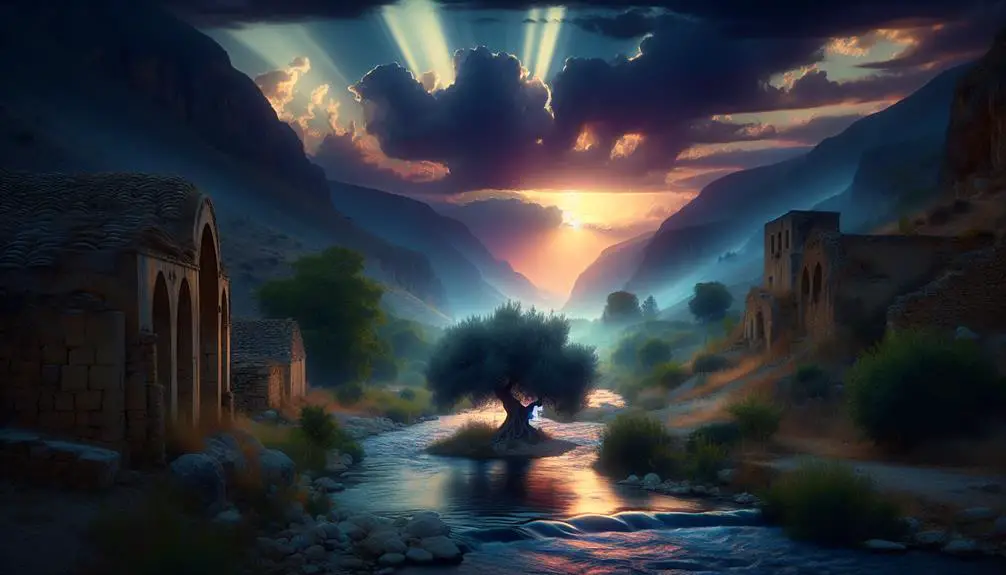
Beyond its physical presence, the Brook Kidron holds profound symbolic meanings within biblical narratives, reflecting themes of purification, judgment, and transition. You'll find that this stream, running between Jerusalem and the Mount of Olives, isn't just a geographical feature; it's a rich tapestry of spiritual symbolism tied closely to ritual purification and eschatological imagery.
In the context of ritual purification, the Brook Kidron represents a natural boundary that must be crossed, signifying a transition from the profane to the sacred. This crossing echoes the purification rites required for entering the Temple, suggesting that one must be cleansed before approaching the divine. The flowing waters of Kidron, therefore, aren't merely physical but are imbued with the symbolism of washing away impurities, preparing individuals for a closer encounter with God.
Eschatologically, Kidron's imagery is even more potent. It serves as a backdrop for final judgment scenes, where the separation of the righteous from the wicked is likened to the crossing of a threshold. The brook, in this light, becomes a boundary between earthly existence and the realm of divine judgment and redemption. This dual role of Kidron, straddling the worlds of the immediate and the ultimate, underscores its significance in the eschatological narratives of the Bible, where it stands as a silent witness to both human frailty and divine grace.
In analyzing these symbolic dimensions, you're invited to see the Brook Kidron not just as a stream of water, but as a flowing conduit of spiritual meaning, deeply entrenched in the biblical tradition of purification, judgment, and the hope of renewal.
Archaeological Discoveries
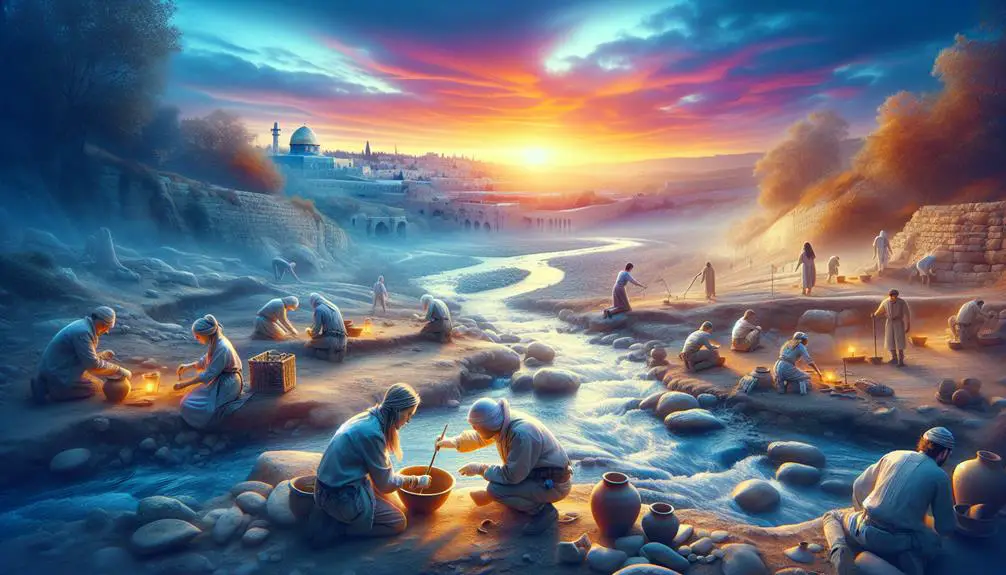
Exploring the Brook Kidron's symbolic dimensions further, recent archaeological findings have unearthed artifacts and structures that provide tangible connections to its storied past, enriching our understanding of its role in biblical history. These discoveries underscore the meticulous nature of excavation methods and the critical importance of artifact preservation in piecing together historical narratives.
Recent excavations in the Kidron Valley have revealed:
- Ancient tombs: These structures, carved directly into the rock face, offer insights into the burial customs and religious beliefs of the people who once inhabited the area.
- Ceremonial pools: Likely used for ritual purification, these pools illuminate the religious practices and daily life of ancient communities.
- Inscriptions and carvings: Texts carved into stone provide direct evidence of the languages, scripts, and expressions of faith among the valley's historical occupants.
- Pottery shards and domestic artifacts: These everyday items give archaeologists clues about the diets, trade networks, and social structures of past societies.
Prophetic References

You'll find that the Brook Kidron not only plays a pivotal role in biblical narratives but also features prominently in prophetic references, shedding light on its spiritual significance. This stream, more than a geographical landmark, is imbued with layers of end time imagery and Messianic symbolism, painting a vivid picture of the eschatological themes woven throughout the Scriptures.
Delving deeper, the prophetic literature utilizes the Brook Kidron as a symbol of separation and purification, a motif that resonates with the cleansing and division foretold in end times prophecy. For instance, its mention alongside significant events and figures emphasizes its role as a boundary—not just physically, but spiritually—between the holy and the profane, the temporal and the eternal.
Moreover, the brook's association with King David's flight from Absalom (2 Samuel 15:23) and later with Jesus's crossing before His arrest (John 18:1) amplifies its Messianic symbolism. These events, separated by centuries, are linked by their passage over Kidron, highlighting themes of suffering, betrayal, and ultimate redemption. This duality serves as a poignant reflection of the Messiah's journey from suffering to sovereignty, encapsulated within the prophetic vision of Scripture.
In essence, the Brook Kidron's presence in prophetic texts is far from incidental. It's a carefully chosen symbol, rich with theological implications. Its waters whisper of purification, its banks bear witness to pivotal moments of transition, and its course charts the path from present tribulations to future glory, embodying the profound journey from messianic prophecy to fulfillment.
Modern-Day Relevance
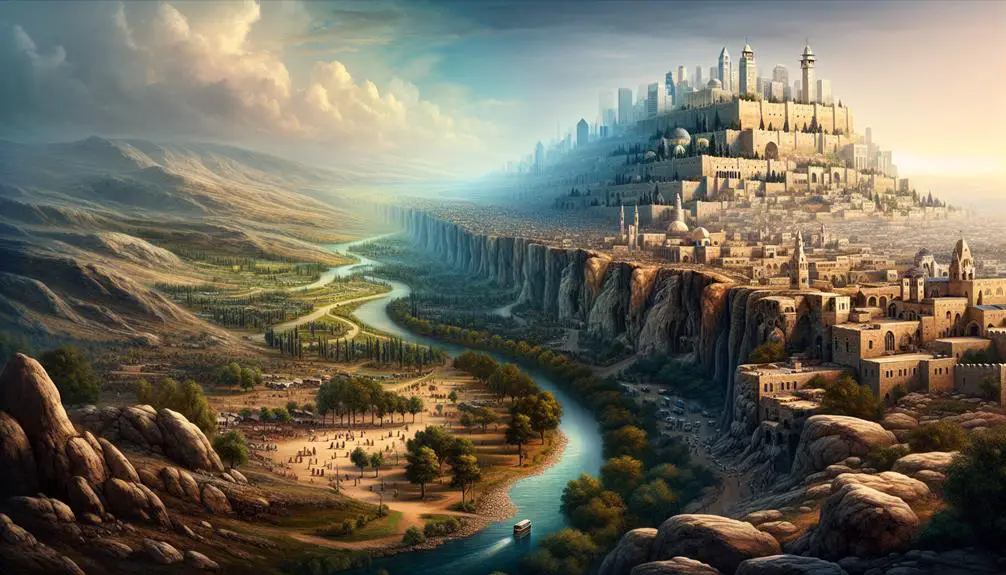
In today's context, the Brook Kidron transcends its ancient biblical significance to mirror contemporary themes of spiritual and societal division. Its narrative now extends to pressing concerns that resonate with modern audiences, particularly in the realms of environmental impact and water conservation. This shift in relevance demonstrates how ancient landmarks can serve as conduits for understanding and addressing contemporary issues.
Here are key aspects of its modern-day relevance:
- Environmental Impact: The Brook Kidron, once a vibrant watercourse, now faces challenges due to urbanization and climate change. Its condition serves as a stark reminder of the environmental degradation that can occur when natural resources aren't protected. The brook's plight highlights the need for sustainable environmental practices that honor the earth's natural heritage.
- Water Conservation: As a region with limited water resources, the importance of conserving water in and around the Brook Kidron can't be overstated. It stands as a critical case study for water conservation efforts, emphasizing the need to manage water sources wisely to ensure their longevity for future generations.
- Cultural Preservation: The Brook Kidron's historical and spiritual significance calls for efforts to preserve its cultural legacy. This involves maintaining its physical and symbolic integrity amidst modern-day challenges.
- Educational Value: By studying the Brook Kidron, individuals gain insights into the intersection of history, religion, and environmental ethics. It offers a unique educational opportunity to explore how ancient texts can inform contemporary environmental stewardship.
Understanding the Brook Kidron in its modern context encourages a deeper appreciation for how ancient landmarks can illuminate current issues and inspire action towards a more sustainable and conscientious future.
Frequently Asked Questions
How Does the Flora and Fauna Around Brook Kidron Today Compare to What It Might Have Been Like in Biblical Times?
You're examining how the flora and fauna around Brook Kidron have evolved, focusing on seasonal changes and water sources.
Originally, this area likely boasted a richer biodiversity, supported by more consistent water sources. Today, climate shifts and human intervention have altered these dynamics, potentially reducing species diversity.
Seasonal changes now play a crucial role, with water scarcity affecting both plant and animal life, diverging significantly from the historical ecological balance.
Are There Any Unique Linguistic Features or Etymological Roots Associated With the Name "Kidron" in Ancient Texts?
You're diving into the linguistic evolution and etymological significance of 'Kidron,' a name steeped in history. This exploration reveals how languages morph over time, shedding light on ancient cultural and societal values.
'Kidron's' roots are a fascinating case study, illustrating the dynamic interplay between language and history. By analyzing these linguistic features, you uncover layers of meaning that enrich your understanding of historical narratives, offering a deeper insight into the past.
What Are Some of the Environmental Challenges That Brook Kidron Faces in the 21st Century, Such as Pollution or Climate Change Impacts?
You're navigating troubled waters when you examine Brook Kidron's environmental challenges. In the 21st century, urban development has encroached upon its banks, exacerbating pollution levels. Water management strategies are sorely tested as climate change introduces erratic weather patterns, further impacting the brook's health.
Analyzing these issues requires a detailed, scholarly approach, delving into how urbanization and shifting climates intertwine to threaten this vital waterway's existence.
Have There Been Any Significant Artistic Representations of Brook Kidron in Christian or Jewish Art Throughout the Centuries?
Yes, there've been significant artistic representations of Brook Kidron over the centuries. The iconographic evolution reflects its importance in both Christian and Jewish art. Early depictions often emphasize its religious significance, while modern interpretations sometimes explore broader themes, including environmental concerns.
Artists have skillfully woven it into various narratives, showcasing its enduring influence. This artistic journey provides a rich tapestry of cultural and religious significance, evolving yet remaining deeply rooted in tradition.
How Do Contemporary Religious Communities, Both Jewish and Christian, Incorporate Brook Kidron Into Their Rituals or Teachings Today?
You might think Brook Kidron's relevance has faded, but today's Jewish and Christian communities deeply integrate it into their rituals and teachings.
Through pilgrimage traditions, believers physically connect with their sacred history, walking paths that echo ancient footsteps.
Ecumenical dialogues around Kidron foster a unique bond, bridging faiths over shared sacred spaces.
This practice isn't just about preservation; it's a living, evolving dialogue, enriching both communities' spiritual journeys.
Conclusion
Ironically, despite the Kidron's pivotal roles in biblical narratives—from David's harrowing escape to Jesus' poignant last night—its physical presence today might seem underwhelming.
Yet, your exploration into its depths, both literal and metaphorical, reveals a riveting contradiction. The brook, seemingly insignificant in size and appearance, holds a reservoir of profound historical, spiritual, and archaeological significance.
It's a stark reminder that in history and faith, the most humble of waters can mirror the deepest of truths.


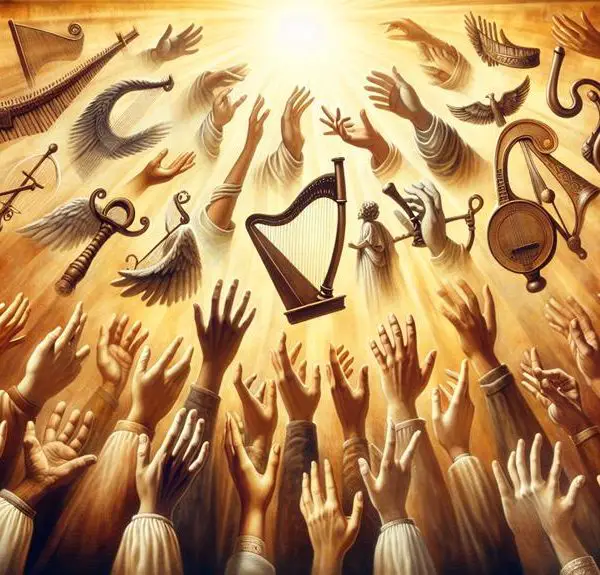
Sign up